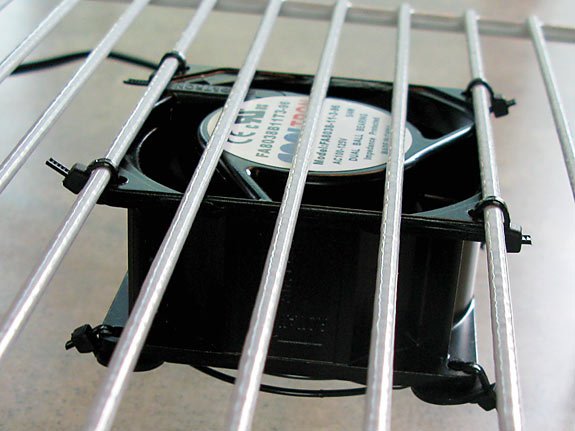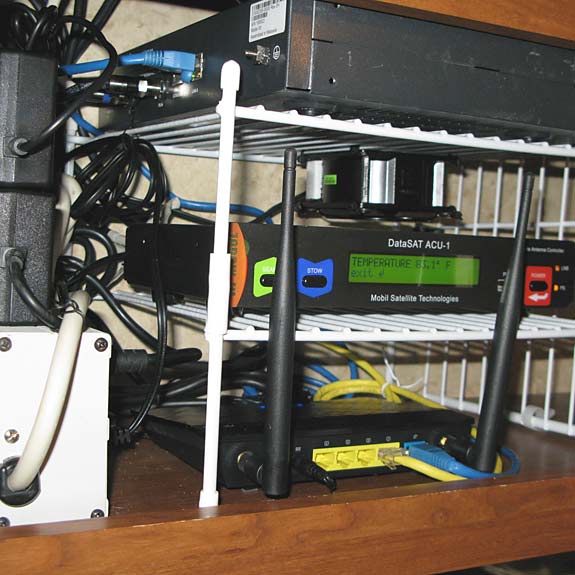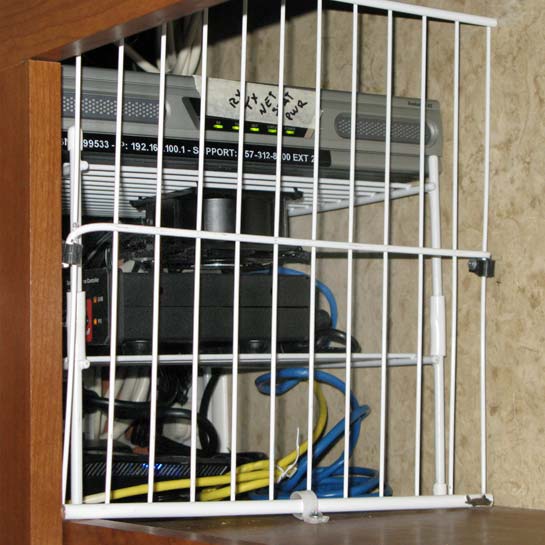Have I mentioned how much I love our new RVDataSat 840 system? 🙂

?
Our new satellite internet system from MobilSat is really cool! Quite literally…now that I’ve built a rack to secure the networking hardware, complete with a cooling fan and surge protector.
Why I Built Our RV Wifi Network Cooling Rack
Now that we have put our new RVDataSat hardware and service to the test for a few weeks, I decided to tidy up the cabinet to secure everything before heading south for the winter. With the iDirect modem, DataSat controller, wireless router and various power supplies all piled on top of each other, things were getting hot up there. Really hot.
Heat may have been what killed our router when boondocking in the desert a couple years ago. Having spent much of my previous life in the computer hardware industry, I know how hot such equipment can get. And I know these components are only rated to operate within certain temperatures.
After getting our RVDataSat 840 installed, I had the pleasure of visiting RF Mogul—the manufacturer, located in Salt Lake City, where the sun was beating down hard. There I learned that there is no concern for our modem or controller until internal temperatures reach 150± degrees. I also discovered the DataSat ACU-1 allows me to monitor these temps.

The controller’s simple front panel menu will display its current operating temperature. And its HTML interface provides complete details about the Modem Status, including it’s temperature. Reaching 131º on that balmy Salt Lake City summer day, I knew I had to rearrange our hardware. It’s much cooler now…

How To Make Cool RV Cabinet Network Rack
I wanted something lightweight and easy to assemble with a small footprint that would fit inside our RV cabinet, and hold the three system components. I found this perfect set of stackable wire shelves on Amazon. They come in various sizes, and I was easily able to adjust the height by cutting the legs as needed to fit each device.

I placed the wireless router on the bottom for optimal positioning of the antennas. And I placed the iDirect modem on top since it seems to get the hottest. On the middle shelf, I placed the dish controller with enough space to mount an AC server cooling fan beneath the modem to keep air circulating as needed.

 Simple steps I took to make the rack:
Simple steps I took to make the rack:
- Cut the first shelf down to just fit the router underneath it.
- Measure the height of second shelf required for controller and fan.
- Mount fan beneath second shelf, with airflow going up.
- Place modem on top rack.
- Secure power supplies and surge protector to wall.
Why an AC fan you ask? We will only ever need have the fan running when the network devices are on, which all require AC power. A DC computer fan may have worked, but that would have required wiring a DC circuit to the cabinet or tapping into the ACU-1 control cable—which I would not do without consulting with MobilSat first.
To protect our investment in satellite internet hardware, the final addition to our network was a surge protector. I strongly recommend a high quality Isobar Surge Protector Power Strip. The Tripp Lite provides isolated filter banks to prevent interference between equipment, and offers Network grade surge suppression rated at 3330 Joules/92,000 amps.

The size of the iDirect modem did not allow me to position its status LEDs facing forward without putting stress on the cables in back. It did just fit in our cabinet by turning it 90 degrees. This allowed for adequate air flow all around, with no pressure on any connections—a good thing considering all the bouncing around that is bound to happen down the road.

Finally, I mounted a piece of coated wire shelving to the cabinet wall, preventing my new network hardware rack from sliding around. This will also keep other items stored in the cabinet from impacting any of the devices or wires.
 Products used in this project:
Products used in this project:
[unordered_list style=”star”]
- RVDataSat 840 by Mobil Satellite Technologies
- Stackable Wire Countertop Shelves
- AC Infinity Standard Cooling Fan
- Closetmaid Wire Shelving
- 4-Inch Cable Ties
- Tripp-Lite Isobar Surge Protector/Power Strip
[/unordered_list]
Another Reason I love our RVDataSat 840
The DataSat controller by Mobil Satellite Technologies is built with “smart” power control. Sudden loss of power will not damage the device, and it will remember the last state it was in when power is cut. This allows me to turn the entire network on or off with the flip of one switch on the surge protector.
I’ve got many other reasons we are happy with our RVDataSat 840 purchase, which I plan to share in future posts.
Any questions so far?
Does the AC fan run continuously or is it switched somehow? Temperature actuated circuit? Or do you simply plug it in as needed? Thanks for your response and any other comments.
I just plug in the fan as needed, since it is only necessary when the cabinet gets really warm. I have an inline switch I plan to install on the cord, but haven’t been anywhere that hot for any length of time to warrant doing do…yet. Thanks for asking!